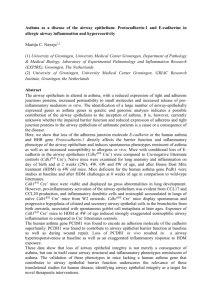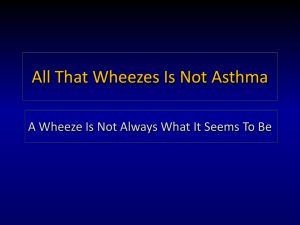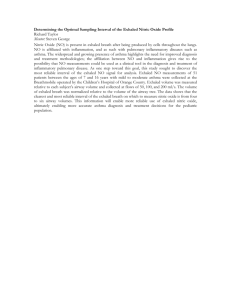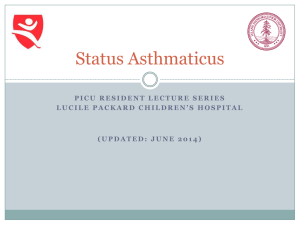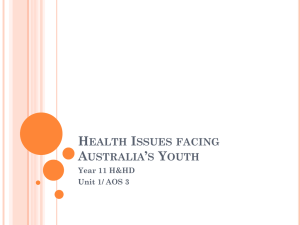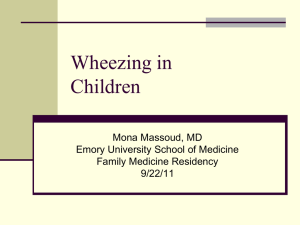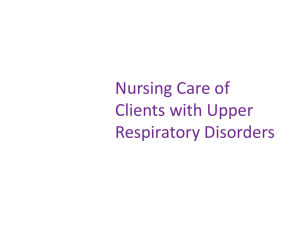SIDs, AW disorders, Asthma, & Plural Disorders Chapters: 31,32,33
advertisement
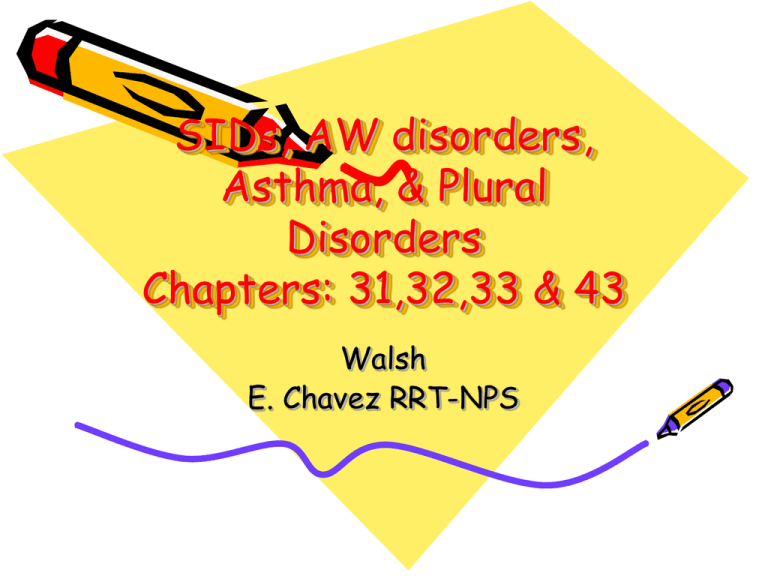
SIDs, AW disorders, Asthma, & Plural Disorders Chapters: 31,32,33 & 43 Walsh E. Chavez RRT-NPS Definition of SIDS • Sudden and unexpected death of an infant for which sufficient cause cannot be found by a death scene investigation, review of the history, and a postmortem • 1week-1 year old (2-4 months < 6months) • ALTE (Apparent life-threatening event) – Color change – Hypotonia – 70% found in the morning….. Risk Factors • Lending for intervention – Prone positioning – Maternal smoking – Bottle-feeding vs Breast feeding???? Normal Control of Heart Rate and Breathing • Breathing – Brainstem • Heart rate – Autonomic nervous system SIDS • Etiology: • Brainstem: controls breathing (Prematurity?) • Central Apnea & periodic breathing • Tests for assessing risk factors – NO test that predicts risk for SIDS – Polysomnography/ pneumogram – Frequency of apnea Polysomnography • Parameters: Pg. 547 Fig 31-3 – EEG (Brain activity) – EOG (Bilateral Eye Movement) – EMG (Muscle tone) impendence belt -EtcO2 -POX/ TCOM -ECG -Ph Probe graph Figure 31-2 (pg 546) • Laboratory Supervision: Pediatrician Who Scores? • Setting: Pediatric Staged with Parent near • Personnel: knowledge of the child's behavior developmental stages Polysomnography (cont.) • Normal sleep development: – REM and NON-REM • Apnea (3 categories) – – – – – – – – – Rapid base line Central: (B’sD’s andColor change) 10-25% Obstruction:hypopnea & apnea OB lasting >10sec or 6-8 sec (UAW OB) Complications: Desat/ > CO2;Day time Sleepiness, behavior changes, cor pulmonale Treatment: Removal of adenoidal & tonsils NCPAP NICU: Reflux, PofA, Hypoxia, anemia, IVH, Seditaives, seizures, incoordiation with feedings Home Cardiorespiratory Monitors= Apnea Monitors • Alert the caregiver to a cardiorespiratory abnormality • Diagnostic devices • Training • Social/parental implications Chapter 32 Pediatric Airway Disorders and Parenchymal Lung Diseases Pediatric Airway Upper airway (Pg. 555 fig. 32-1) Above C3-4 Peds non expandable Cricoid rings (Narrowest portion) -obligate nose breathers 3-6 months Poor coronation between rr& oropharngeal motor skills & large tongues Developement up to 8 years of age • Lower airway: • Trachea > Subdivisions 17-16: adults23 generations…..RSV ? • Airway obstruction: • AP/ Lateral Neck-XRAY • Assessments: RDS, Auscultate UAW: Air movement muffled/stridor Upper Airway Disorders lesions, inflammatory, abnormal tissue, tone • Supralaryngeal obstruction – – – – Choanal atresia Pierre Robin syndrome Deep neck infections Tonsillar enlargement/Peritonsillar abscess – Obstructive apnea Upper Airway Disorders (cont.) • Periglottic obstruction (around the glottis) – Epiglottis – Laryngotracheobronchitis (LTB-CROUP) – Table 32-1 Differential Diagnosis – Pg. 559 Epiglottitis Life Threatening =Bacterial infection (H influenza B) • Incidence and etiology – <6 years old – Noninfectious: aspiration of hot liquid, traumatic intubations, blind finger sweep • Signs and symptoms: ABRUPT • Fever, soar throat, dysphagia(drooling) • MUFFLED, retractions, RDS, upright sniffing position • Diagnosis: lateral NECk (Thumb sign) C&S, ABG • Treatment: (small?) ETT, RSI, ceftriaxone, Extubate leak?Bronchoscope, antibotcs Epiglottitis (cont.) Laryngotracheobronchitis LTB-CROUP (6 months-6 years) • Incidence and etiology: • Parainfluenza Virus 1 • Over several days • Signs and symptoms: • Low grade fever, malasise, rhinorrhea, hoarse voice BARKY COUGH • Diagnosis: • Lateral neck-xray: Steeple sign (SUBglottic) • Treatment: Racemic Epi, hydration, temp ……………..control, humidification, Mist tents, O2, >0.35Fio2= impending resp Failure Intubations Laryngotracheobronchitis (cont.) Lower Airway Disorders • Obstruction of the trachea and major bronchi – Tracheomalacia – Congenital tracheal or bronchial stenosis Lower Airway Disorders pg563 • Foreign body aspiration – Incidence: • Leading cause of accidental death – Signs and symptoms: – – – – – – • Degree of AW OB • Unilateral Wheezing/ reoccurring PNA Diagnosis: AP CXR/neck and lateral Laryngeal level Hyperinflation/Ball valve effect Bronchoscopy Treatment: Removal of object continue to monitor patient Foreign Body Aspiration Lower Airway Disorders • Atelectasis – Etiology and pathophysiology: • Failure to reinflate – Signs and symptoms: • Dyspnea • (Severe) V/Q mismatch • RDS – Diagnosis: CXR, B/S, tracheal deviation – Treatment: Hyperinflation therapy, Bronchial hygiene therapy, Lower Airway Disorders • Bronchiectasis: • Irreversible dilation of the bronical tree – Etiology and pathology • CF/ frequent respiratory infections • Left lower lobes mostly involved – Signs and symptoms: • Chronic cough w/ copious amts of purulent sputum – Diagnosis: CXR and CT – Treatment: CPT, hydration, antibotics, Lower Airway Disorders • Acute bronchiolitis – Etiology: Viral Respiratory Tract infection related to RSV – Incidence:<1 year of age with BPD, CF, PPHN & CHD – Signs and symptoms: coryza, cough, RDS, wheezing (APNEA), dehydration – Diagnosis:Nasal Swab: +RSV – Treatment:O2, (MV), IV, Supportive care – Prognosis: GOOD Pneumonia • Viral – 1st:Respiratory syncytial virus (RSV) • Coryza, NASAL CONGESTION, cough & fever • Supportive Care vs. Ribavirin – 2nd:Parainfluenza virus Types1(LTB), 2, and 3(children<5yr) • O2 and supportive care – Influenza virus: • Winter seasons • Vaccinations yearly – Adenovirus: – High rates of M & M. – Overwhelming sepsis – Supportive care Pneumonia • Bacterial – Incidence: Compromised immune function, recurrent aspiration, malnutrition, daycare, passive cigarette – Etiology: microorganisms colonize in the URT – Signs and symptoms: same as viral – Diagnosis: CXR, > total band count>1500, CRP, Blood Culture – Treatment: oral/ IV antibiotics – 7-14 days – Pox & ABG Chapter 33 PG. 582-597 Asthma Most common chronic childhood disease Pathogenesis • Definition:Chronic inflammatory disorder of the AWs – Mast cells, eosinophils, T lympocytes, IgE, Macrophages, neutrolphils, & epithelial cells – Wheezing &Breathlessness Pathogenesis of Asthma • Pathophysiology – Chronic airway inflammation – Bronchial hyperresponsiveness – Hypersecretion of mucus • Components of Asthma: – – – – Inflammation -A remodeling Bronchial constriction -Mucous plugging AW edema -AW Hyperreponsiveness RESULTS: • HYPERinflation, atelectasis, hypoxia, V/Q mismatch, Hypercarbia Risk Factors for Developing Asthma • Allergic response: – IgE – Reversible vs. irreversible – AW remoding=fibrosis • Environmental triggers – Intervention – Remediate & eliminate • Tobacco • Cockroaches/ Dust mites • Molds National Asthma Education and Prevention Program • Purpose: • to serve as a comprehensive tool to diagnosis and manage asthma • Goals: Box 33-1: – Prevent: Chronic asthma, recurrent – Maintain: NL ADLs, NL/near NL pulmonary function – Optimal pharmacology – Meet family & patient’s expectations Diagnosis • Medical history: – Symptoms & triggers • Physical examination: – History a stronger factor – Prolongs expiratory phase – RDS, Hyperexpansion • Pulmonary function testing: – FVC, FEV1 <80% predicted, FEV1/FV(< 65% predicted), FEF25-75% • Bronchoprovocational challenges (methacholine 20% decrease=+test) • Exercise: running/biking – Less sensitive HR > 170 Management • Pharmacologic therapy – Long-term control medications • Taken daily • Antiinflammatoryagents/ corticosteroids • Long acting B2 agonist(LABAs) • • • • – Salmeterol & Formoterol 30-90 minutes Methylxanthines Leukotriene modifiers: inhibits Cromolyn sodium (Stablizes mast cells) Immnuomodulators: Binds to IgE Management – Quick-relief medications: (5-15 minutes) • Short acting B-agonist last 4-6 hours • “rescue” • Anticholenergics – Delivery systems • MDI (Spacers & holding chambers) • DPI • SVN Management (cont.) • Control of triggers – Identification of allergens – Avoidance and control measures – Immunotherapy • controversial Management (cont.) • Peak flow monitoring – – – – Peak flow meter Peak flow diary Personal best reading Peak flow zone system – Pg. 593 Patient and Family Education • • • • Asthma disease process Medication skills Identification and control of triggers Self-monitoring techniques Managing Asthma • Exacerbations in the ED – Assessment: PF of airflow, POX – Beta-2 agonists – Corticosteroids Managing Asthma (cont.) • Hospitalization and respiratory failure BOX 33-8 (Criteria for hospitalization) – Intubation • Elective • Respiratory Fatigue – Mechanical ventilation • Low Vt – PS ventilation Based on the degree of sedation – I:E ratio for adequate ventilation – Prone to pneumothorases, barotrauma, per > PIP, & hypotension Asthma • Exercise-induced bronchospasm (EIB) – 5-10 minutes after activity • Asthma at school – Teachers – Self esteem • Asthma camps – AHA • SCAMP CAMP Chapter 43 Pg. 706-714 Disorders of the Pleura Pleural Effusion • Clinical signs: – Decrease in B/S, Dullness to percussion compared to the contralateral – Tachypnea and pain • Diagnosis: CXR • Tx:Thoracentesis • Laboratory studies: Transudate vs. Exudate, empyema (-Tube) • Causes:BOX 43-2 & 43-3 (pg. 708) • Complications: • • • pneumothorax Hemorrhage Infections PLEURAL EFFUSION Pneumothorax • Clinical signs: – Chest pain & SOB – Decrease breathsounds on affected side with hyperresonnance • Diagnosis: CXR • Treatment: – Nitrogen washout – Needle aspiration – CT HydroPneumothorax (cont.) Thoracostomy Drainage • Indications: Drainge of air/ fluid • Procedure for placement – – – – Conscious sedation Role of the respiratory therapist Assist/ Place Drainages system (3 bottles) Thoracostomy Drainage (cont.) Surgery in the Pleural Space • Treatment of empyema • Thoracoscopy • Chemical pleurodesis

